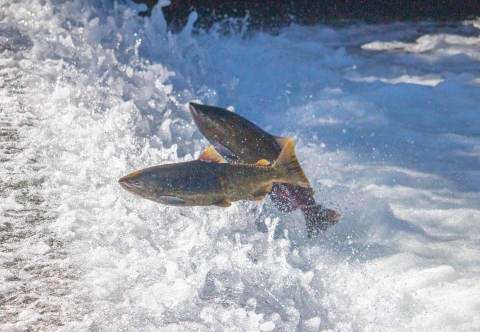Featured Species
The hatchery raises Chinook salmon (Oncorhynchus tshawytscha) and steelhead (Oncorhynchus mykiss).
Chinook salmon
The hatchery raises three runs of Chinook salmon (fall, late-fall and winter runs), all fish are released into Battle Creek, a tributary of the Sacramento River.
Chinook salmon are the largest of all the Pacific salmon and can be identified by their black gums, and irregular black spots on their back and on the caudal and dorsal fins. In the ocean Chinook salmon are a silvery color with dark backs and lighter bellies. When they return to freshwater to spawn the fish turn darker grey in color and the males tend to develop more red coloring than the females. When spawning males are easily distinguishable by their long hooked jaw, known as a kype; females tend to have a smaller snout and a fatter body that is full of eggs.
Chinook salmon are anadromous meaning they begin and end their lives in freshwater, but live the majority of their lives in salt water. Fish released at the hatchery as juveniles can reach the San Francisco Bay Delta in as little as six days. When the juveniles reach the ocean they begin feeding on zooplankton and insects and as they grow they begin to eat shrimp and other fish. They spend 2-3 years in the ocean before making the 250 mile journey back to the hatchery to spawn and die...completing their natural life cycle.
Steelhead
Steelhead are the anadromous form of rainbow trout. The hatchery spawns steelhead during January and February of each year and releases juveniles (from the previous spawning season) in Janaury. Steelhead juveniles are released directly into the Sacramento River.
Unlike Chinook salmon, steelhead can spawn multiple times in their lives. Adult steelhead are kept alive during the spawning process and released back into Battle Creek once the spawning season has ended. Some fish have been documented returning to the hatchery to spawn multiple years in a row.




